Neuropsychological Effects of Air Pollution on Children and Adolescents (0–18 Years): A Global Bibliometric Analysis
Abstract
1. Introduction
2. Methods
2.1. Data Sources and Retrieval Strategy
2.2. Literature Screening
2.3. Data Analysis
3. Results and Discussion
3.1. Analysis of the Number of Publication on the Impact of Air Pollution on the Neuro-Mental Health of Children and Adolescents
3.2. Country and Institutional Research Mapping Analysis
3.3. Keyword Co-Occurrence and Clustering Analysis
3.4. Burst Keyword Detection and Temporal Evolution
3.5. Author Collaboration Network
3.6. Co-Citation of References
3.7. International Collaboration Network Analysis
3.8. Overlay of Dual Maps Analysis
4. Conclusions
- (1)
- Research question 1: Research scale and trajectory
- (2)
- Research question 2: Core topics and keywords
- (3)
- Research question 3: Leading scholars and collaboration
- (4)
- Research question 4: Disciplinary characteristics and integration
- (5)
- Research question 5: Geographic patterns and hotspots
- (6)
- Research question 6: Leading countries/institutions and collaboration
- (7)
- Research question 7: Core journals
5. Outlook
Author Contributions
Funding
Institutional Review Board Statement
Informed Consent Statement
Data Availability Statement
Conflicts of Interest
Appendix A. Database Search Strategy
- TS = ((“air pollution” OR “PM2.5” OR “NO2” OR “ozone” OR “particulate matter”) AND (child* OR adolescent* OR pediatric OR teenager OR youth) AND (“neurological effects” OR neurodevelopment OR “cognitive function” OR “mental health” OR “nervous system” OR “brain development” OR “behavioral disorder*” OR ADHD OR autism OR “learning disability”))
- (TITLE-ABS-KEY ((“air pollution” OR “PM2.5” OR “NO2” OR “ozone” OR “particulate matter”)) AND (TITLE-ABS-KEY (“child*” OR “adolescent*” OR “pediatric” OR “teenager” OR “youth”)) AND (TITLE-ABS-KEY (“neurological effects” OR “neurodevelopment” OR “cognitive function” OR “mental health” OR “nervous system” OR “brain development” OR “behavioral disorder*” OR “ADHD” OR “autism” OR “learning disability”)))
References
- Moura, P.C.; Raposo, M.; Vassilenko, V. Breath volatile organic compounds (VOCs) as biomarkers for the diagnosis of pathological conditions: A review. Biomed. J. 2023, 46, 100623. [Google Scholar] [CrossRef] [PubMed]
- Costa, L.G.; Cole, T.B.; Dao, K.; Chang, Y.-C.; Coburn, J.; Garrick, J.M. Effects of air pollution on the nervous system and its possible role in neurodevelopmental and neurodegenerative disorders. Pharmacol. Ther. 2020, 210, 107523. [Google Scholar] [CrossRef] [PubMed]
- Scardino, B.; Dicharry, D.; Agrawal, A.; Xing, D.; Bhuiyan, M.M.R.; Bhuiyan, M.S.; Rom, O.; Conrad, S.A.; Vanchiere, J.A.; Orr, A.W.; et al. Cumulative environmental exposures and metabolic syndrome: A study of heavy metals and volatile organic compounds. Ecotoxicol. Environ. Saf. 2025, 297, 118238. [Google Scholar] [CrossRef] [PubMed]
- Sicard, P.; Agathokleous, E.; Anenberg, S.C.; De Marco, A.; Paoletti, E.; Calatayud, V. Trends in urban air pollution over the last two decades: A global perspective. Sci. Total Environ. 2023, 858, 160064. [Google Scholar] [CrossRef]
- Castagna, A.; Mascheroni, E.; Fustinoni, S.; Montirosso, R. Air pollution and neurodevelopmental skills in preschool- and school-aged children: A systematic review. Neurosci. Biobehav. Rev. 2022, 136, 104623. [Google Scholar] [CrossRef]
- Bai, L.; Wang, K.; Liu, D.; Wu, S. Potential Early Effect Biomarkers for Ambient Air Pollution Related Mental Disorders. Toxics 2024, 12, 454. [Google Scholar] [CrossRef]
- World Health Organization. Available online: https://www.who.int/publications/i/item/9789240034228/ (accessed on 10 April 2025).
- Sun, J.; Zhou, Z.; Huang, J.; Li, G. A bibliometric analysis of the impacts of air pollution on children. Int. J. Environ. Res. Public Health 2020, 17, 1277. [Google Scholar] [CrossRef]
- Loftus, C.T.; Ni, Y.; Szpiro, A.A.; Hazlehurst, M.F.; Tylavsky, F.A.; Bush, N.R.; Sathyanarayana, S.; Carroll, K.N.; Young, M.; Karr, C.J.; et al. Exposure to ambient air pollution and early childhood behavior: A longitudinal cohort study. Environ. Res. 2020, 183, 109075. [Google Scholar] [CrossRef]
- Dow-Edwards, D.; MacMaster, F.P.; Peterson, B.S.; Niesink, R.; Andersen, S.; Braams, B.R. Experience during adolescence shapes brain development: From synapses and networks to normal and pathological behavior. Neurotoxicology Teratol. 2019, 76, 106834. [Google Scholar] [CrossRef]
- Xie, H.; Cao, Y.; Li, J.; Lyu, Y.; Roberts, N.; Jia, Z. Affective disorder and brain alterations in children and adolescents exposed to outdoor air pollution. J. Affect. Disord. 2023, 331, 413–424. [Google Scholar] [CrossRef]
- Cory-Slechta, D.A.; Sobolewski, M.; Oberdörster, G. Air Pollution-Related Brain Metal Dyshomeostasis as a Potential Risk Factor for Neurodevelopmental Disorders and Neurodegenerative Diseases. Atmosphere 2020, 11, 1098. [Google Scholar] [CrossRef]
- Levy, R.J. Carbon monoxide pollution and neurodevelopment: A public health concern. Neurotoxicology Teratol. 2015, 49, 31–40. [Google Scholar] [CrossRef]
- Mazahir, F.A.; Shukla, A.; Albastaki, N.A. The association of particulate matter PM2.5 and nitrogen oxides from ambient air pollution and mental health of children and young adults- a systematic review. Rev. Environ. Health 2025, 40, 495–536. [Google Scholar] [CrossRef]
- Mok, P.L.; Antonsen, S.; Agerbo, E.; Brandt, J.; Geels, C.; Christensen, J.H.; Frohn, L.M.; Pedersen, C.B.; Webb, R.T. Exposure to ambient air pollution during childhood and subsequent risk of self-harm: A national cohort study. Prev. Med. 2021, 152, 106502. [Google Scholar] [CrossRef]
- Bellinger, D.C.; Matthews-Bellinger, J.A.; Kordas, K. A developmental perspective on early-life exposure to neurotoxicants. Environ. Int. 2016, 94, 103–112. [Google Scholar] [CrossRef] [PubMed]
- Lane, M.; Oyster, E.; Luo, Y.; Wang, H. The Effects of Air Pollution on Neurological Diseases: A Narrative Review on Causes and Mechanisms. Toxics 2025, 13, 207. [Google Scholar] [CrossRef] [PubMed]
- Liu, X.-Q.; Huang, J.; Song, C.; Zhang, T.-l.; Liu, Y.-P.; Yu, L. Neurodevelopmental toxicity induced by PM2.5 Exposure and its possible role in Neurodegenerative and mental disorders. Hum. Exp. Toxicol. 2023, 42, 09603271231191436. [Google Scholar] [CrossRef] [PubMed]
- Veras, M.M.; Saldiva, P.H.N. Impact of air pollution and climate change on maternal, fetal and postnatal health. J. Pediatr. 2025, 101, S48–S55. [Google Scholar] [CrossRef]
- Vaiserman, A. Epidemiologic evidence for association between adverse environmental exposures in early life and epigenetic variation: A potential link to disease susceptibility? Clin. Epigenetics 2015, 7, 96. [Google Scholar] [CrossRef]
- Younan, D.; Tuvblad, C.; Franklin, M.; Lurmann, F.; Li, L.; Wu, J.; Berhane, K.; Baker, L.A.; Chen, J.-C. Longitudinal analysis of particulate air pollutants and adolescent delinquent behavior in Southern California. J. Abnorm. Child Psychol. 2018, 46, 1283–1293. [Google Scholar] [CrossRef]
- Sunyer, J.; Esnaola, M.; Alvarez-Pedrerol, M.; Forns, J.; Rivas, I.; López-Vicente, M.; Suades-González, E.; Foraster, M.; Garcia-Esteban, R.; Basagaña, X.; et al. Association between traffic-related air pollution in schools and cognitive development in primary school children: A prospective cohort study. PLoS Med. 2015, 12, e1001792. [Google Scholar] [CrossRef]
- Jin, J.; Wan, Y.; Shu, Q.; Liu, J.; Lai, D. Knowledge mapping and research trends of IL-33 from 2004 to 2022: A bibliometric analysis. Front. Immunol. 2023, 14, 1158323. [Google Scholar] [CrossRef]
- Kumar, R. Bibliometric Analysis: Comprehensive Insights into Tools, Techniques, Applications, and Solutions for Research Excellence. Spectr. Eng. Manag. Sci. 2025, 3, 45–62. [Google Scholar] [CrossRef]
- Cobo, M.J.; López-Herrera, A.G.; Herrera-Viedma, E.; Herrera, F. Science mapping software tools: Review, analysis, and cooperative study among tools. J. Am. Soc. Inf. Sci. Technol. 2011, 62, 1382–1402. [Google Scholar] [CrossRef]
- Dima, A.; Bugheanu, A.-M.; Boghian, R.; Madsen, D.Ø. Mapping knowledge area analysis in e-learning systems based on cloud computing. Electronics 2022, 12, 62. [Google Scholar] [CrossRef]
- Synnestvedt, M.B.; Chen, C.; Holmes, J.H. CiteSpace II: Visualization and Knowledge Discovery in Bibliographic Databases. AMIA Annu. Symp. Proc. 2005, 2005, 724–728. [Google Scholar]
- Chen, C. CiteSpace II: Detecting and visualizing emerging trends and transient patterns in scientific literature. J. Am. Soc. Inf. Sci. Technol. 2006, 57, 359–377. [Google Scholar] [CrossRef]
- Aria, M.; Cuccurullo, C. bibliometrix: An R-tool for comprehensive science mapping analysis. J. Informetr. 2017, 11, 959–975. [Google Scholar] [CrossRef]
- Li, P.; Yang, G.; Wang, C. Visual topical analysis of library and information science. Scientometrics 2019, 121, 1753–1791. [Google Scholar] [CrossRef]
- Chen, H.; Jin, Q.; Wang, X.; Xiong, F. Profiling academic-industrial collaborations in bibliometric-enhanced topic networks: A case study on digitalization research. Technol. Forecast. Soc. Change 2022, 175, 121402. [Google Scholar] [CrossRef]
- Shi, Y.; Ramayah, T.; Luo, H.; Zhang, Y.; Wang, W. Analysing the current status, hotspots, and future trends of technology management: Using the WoS and scopus database. Heliyon 2023, 9, e19922. [Google Scholar] [CrossRef]
- Zhong, D.; Li, Y.; Huang, Y.; Hong, X.; Li, J.; Jin, R. Molecular mechanisms of exercise on cancer: A bibliometrics study and visualization analysis via CiteSpace. Front. Mol. Biosci. 2022, 8, 797902. [Google Scholar] [CrossRef] [PubMed]
- Wang, T.; Xu, H.; Li, C.; Zhang, F.; Wang, J. Dynamic insights into research trends and trajectories in early reading: An analytical exploration via dynamic topic modeling. Front. Psychol. 2024, 15, 1326494. [Google Scholar] [CrossRef] [PubMed]
- Fang, Y. Visualizing the structure and the evolving of digital medicine: A scientometrics review. Scientometrics 2015, 105, 5–21. [Google Scholar] [CrossRef]
- Chen, J.; Hu, L.; Chen, Q.; Yang, T.; Yi, C. Hotspots and trends in solar-driven interfacial evaporation technology based on bibliometric management and analysis. Surf. Interfaces 2024, 46, 104184. [Google Scholar] [CrossRef]
- Chen, J.; Gui, P.; Ding, T.; Na, S.; Zhou, Y. Optimization of transportation routing problem for fresh food by improved ant colony algorithm based on tabu search. Sustainability 2019, 11, 6584. [Google Scholar] [CrossRef]
- Guo, X.; Zhang, H.; Su, Y.; Zhou, Y. Recent trends in CO2 reduction through various catalytic methods to achieve carbon-neutral goals: A comprehensive bibliometric analysis. Front. Energy 2025, 19, 500–520. [Google Scholar] [CrossRef]
- Hu, L.; Chen, Q.; Yang, T.; Yi, C.; Chen, J. Visualization and Analysis of Hotspots and Trends in Seafood Cold Chain Logistics Based on CiteSpace, VOSviewer, and RStudio Bibliometrix. Sustainability 2024, 16, 6502. [Google Scholar] [CrossRef]
- Li, X.; Guo, X.; Chen, J.; Yi, C. Visualization Study on Trends and Hotspots in the Field of Urban Air Pollution in Metropolitan Areas and Megacities: A Bibliometric Analysis via Science Mapping. Atmosphere 2025, 16, 430. [Google Scholar] [CrossRef]
- Rosenfield, P.L. The potential of transdisciplinary research for sustaining and extending linkages between the health and social sciences. Soc. Sci. Med. 1992, 35, 1343–1357. [Google Scholar] [CrossRef]
- Romanello, M.; Di Napoli, C.; Drummond, P.; Green, C.; Kennard, H.; Lampard, P.; Scamman, D.; Arnell, N.; Ayeb-Karlsson, S.; Ford, L.B.; et al. The 2022 report of the Lancet Countdown on health and climate change: Health at the mercy of fossil fuels. Lancet 2022, 400, 1619–1654. [Google Scholar] [CrossRef]
- Meghji, J.; Mortimer, K.; Agusti, A.; Allwood, B.W.; Asher, I.; Bateman, E.D.; Bissell, K.; Bolton, C.E.; Bush, A.; Celli, B.; et al. Improving lung health in low-income and middle-income countries: From challenges to solutions. Lancet 2021, 397, 928–940. [Google Scholar] [CrossRef] [PubMed]
- Tangermann, L.; Vienneau, D.; Hattendorf, J.; Saucy, A.; Künzli, N.; Schäffer, B.; Wunderli, J.M.; Röösli, M. The association of road traffic noise with problem behaviour in adolescents: A cohort study. Environ. Res. 2022, 207, 112645. [Google Scholar] [CrossRef] [PubMed]
- Szwed, M.; de Jesus, A.V.; Kossowski, B.; Ahmadi, H.; Rutkowska, E.; Mysak, Y.; Baumbach, C.; Kaczmarek-Majer, K.; Degórska, A.; Skotak, K.; et al. Air pollution and cortical myelin T1w/T2w ratio estimates in school-age children from the ABCD and NeuroSmog studies. Dev. Cogn. Neurosci. 2025, 73, 101538. [Google Scholar] [CrossRef] [PubMed]
- Su, X.; Zhang, S.; Lin, Q.; Wu, Y.; Yang, Y.; Yu, H.; Huang, S.; Luo, W.; Wang, X.; Lin, H.; et al. Prenatal exposure to air pollution and neurodevelopmental delay in children: A birth cohort study in Foshan, China. Sci. Total Environ. 2022, 816, 151658. [Google Scholar] [CrossRef]
- Yuchi, W.; Brauer, M.; Czekajlo, A.; Davies, H.W.; Davis, Z.; Guhn, M.; Jarvis, I.; Jerrett, M.; Nesbitt, L.; Oberlander, T.F.; et al. Neighborhood environmental exposures and incidence of attention deficit/hyperactivity disorder: A population-based cohort study. Environ. Int. 2022, 161, 107120. [Google Scholar] [CrossRef]
- Wang, S.-Y.; Cheng, Y.-Y.; Guo, H.-R.; Tseng, Y.-C. Air pollution during pregnancy and childhood autism spectrum disorder in Taiwan. Int. J. Environ. Res. Public Health 2021, 18, 9784. [Google Scholar] [CrossRef]
- Schroeder, H. Developmental brain and behavior toxicity of air pollutants: A focus on the effects of polycyclic aromatic hydrocarbons (PAHs). Crit. Rev. Environ. Sci. Technol. 2011, 41, 2026–2047. [Google Scholar] [CrossRef]
- Jedrychowski, W.; Majewska, R.; Spengler, J.; Camann, D.; Roen, E.; Perera, F. Prenatal exposure to fine particles and polycyclic aromatic hydrocarbons and birth outcomes: A two-pollutant approach. Int. Arch. Occup. Environ. Health 2017, 90, 255–264. [Google Scholar] [CrossRef]
- Zhang, Y.; Chen, L.; Jiang, J.; Ma, T.; Liu, J.; Yuan, W.; Guo, T.; Chen, M.; Wang, R.; Dong, Y.; et al. Research on the association between ambient PM2.5 and its components and psychological distress among Chinese children and adolescents aged 9–18 years. Chin. J. Epidemiol. 2023, 44, 1575–1582. [Google Scholar] [CrossRef]
- Chen, C. Science Mapping: A Systematic Review of the Literature. J. Data Inf. Sci. 2017, 2, 1–40. [Google Scholar] [CrossRef]
- Wang, Y.; Huo, X.; Li, W.; Xiao, L.; Li, M.; Wang, C.; Sun, Y.; Sun, T. Knowledge atlas of the co-occurrence of epilepsy and autism: A bibliometric analysis and visualization using VOSviewer and CiteSpace. Neuropsychiatr. Dis. Treat. 2022, 18, 2107–2119. [Google Scholar] [CrossRef]
- Zong, Z.; Zhang, M.; Xu, K.; Zhang, Y.; Hu, C. Association between short-term exposure to ozone and heart rate variability: A systematic review and meta-analysis. Int. J. Environ. Res. Public Health 2022, 19, 11186. [Google Scholar] [CrossRef] [PubMed]
- Shrivastav, A.; Swetanshu; Singh, P. The impact of environmental toxins on cardiovascular diseases. Curr. Probl. Cardiol. 2024, 49, 102120. [Google Scholar] [CrossRef] [PubMed]
- Ritz, B.; Liew, Z.; Yan, Q.; Cuia, X.; Virk, J.; Ketzel, M.; Raaschou-Nielsen, O. Air pollution and autism in Denmark. Environ. Epidemiol. 2018, 2, e028. [Google Scholar] [CrossRef] [PubMed]
- Zubizarreta-Arruti, U.; Bosch, R.; Soler Artigas, M.; Cabana-Dominguez, J.; Llonga, N.; Carabi-Gassol, P.; Macias-Chimborazo, V.; Vilar-Ribo, L.; Ramos-Quiroga, J.A.; Pagerols, M.; et al. Associations between air pollution and surrounding greenness with internalizing and externalizing behaviors among schoolchildren. Child Adolesc. Ment. Health 2025, 30, 149–158. [Google Scholar] [CrossRef]
- Yolton, K.; Khoury, J.C.; Burkle, J.; LeMasters, G.; Cecil, K.; Ryan, P. lifetime exposure to traffic-related air pollution and symptoms of depression and anxiety at age 12 years. Environ. Res. 2019, 173, 199–206. [Google Scholar] [CrossRef]
- Zhu, X.; Qiu, H.; Wang, L.; Duan, Z.; Yu, H.; Deng, R.; Zhang, Y.; Zhou, L. Risks of hospital admissions from a spectrum of causes associated with particulate matter pollution. Sci. Total Environ. 2019, 656, 90–100. [Google Scholar] [CrossRef]
- Xiang, A.H.; Lin, J.C.; Chow, T.; Yu, X.; Martinez, M.P.; Chen, Z.; Eckel, S.P.; Schwartz, J.; Lurmann, F.W.; Kleeman, M.J.; et al. Discordant sibling analysis of autism risk associated with prenatal exposure to tailpipe and non-tailpipe particulate matter pollution. Environ. Res. 2025, 275, 121449. [Google Scholar] [CrossRef]
- Chen, C.; Ibekwe-SanJuan, F.; Hou, J. The structure and dynamics of cocitation clusters: A multiple-perspective cocitation analysis. J. Am. Soc. Inf. Sci. Technol. 2010, 61, 1386–1409. [Google Scholar] [CrossRef]
- Wang, P.; Tuvblad, C.; Younan, D.; Franklin, M.; Lurmann, F.; Wu, J.; Baker, L.A.; Chen, J.-C. Socioeconomic disparities and sexual dimorphism in neurotoxic effects of ambient fine particles on youth IQ: A longitudinal analysis. PLoS ONE 2017, 12, e0188731. [Google Scholar] [CrossRef]
- Ren, Y.; Yao, X.; Liu, Y.; Liu, S.; Li, X.; Huang, Q.; Liu, F.; Li, N.; Lu, Y.; Yuan, Z.; et al. Outdoor air pollution pregnancy exposures are associated with behavioral problems in China’s preschoolers. Environ. Sci. Pollut. Res. 2019, 26, 2397–2408. [Google Scholar] [CrossRef]
- Murphy, M.S.; Abdulaziz, K.E.; Lavigne, É.; Erwin, E.; Guo, Y.; Dingwall-Harvey, A.L.; Stieb, D.; Walker, M.C.; Wen, S.W.; Shin, H.H. Association between prenatal air pollutant exposure and autism spectrum disorders in young children: A matched case-control study in Canada. Environ. Res. 2024, 261, 119706. [Google Scholar] [CrossRef]
- Chen, J.; Chen, Q.; Hu, L.; Yang, T.; Yi, C.; Zhou, Y. Unveiling trends and hotspots in air pollution control: A bibliometric analysis. Atmosphere 2024, 15, 630. [Google Scholar] [CrossRef]
- Gmür, M. Co-citation analysis and the search for invisible colleges: A methodological evaluation. Scientometrics 2003, 57, 27–57. [Google Scholar] [CrossRef]
- Volk, H.E.; Lurmann, F.; Penfold, B.; Hertz-Picciotto, I.; McConnell, R. Traffic-related air pollution, particulate matter, and autism. JAMA Psychiatry 2013, 70, 71–77. [Google Scholar] [CrossRef] [PubMed]
- Raz, R.; Roberts, A.L.; Lyall, K.; Hart, J.E.; Just, A.C.; Laden, F.; Weisskopf, M.G. Autism Spectrum Disorder and Particulate Matter Air Pollution before, during, and after Pregnancy: A Nested Case–Control Analysis within the Nurses’ Health Study II Cohort. Environ. Health Perspect. 2015, 123, 264–270. [Google Scholar] [CrossRef] [PubMed]
- Lopuszanska, U.; Samardakiewicz, M. The Relationship between Air Pollution and Cognitive Functions in Children and Adolescents: A Systematic Review. Cogn. Behav. Neurol. 2020, 33, 157–178. [Google Scholar] [CrossRef]
- Zundel, C.G.; Ryan, P.; Brokamp, C.; Heeter, A.; Huang, Y.; Strawn, J.R.; Marusak, H.A. Air pollution, depressive and anxiety disorders, and brain effects: A systematic review. NeuroToxicology 2022, 93, 272–300. [Google Scholar] [CrossRef]
- Dadvand, P.; Tischer, C.; Estarlich, M.; Llop, S.; Dalmau-Bueno, A.; López-Vicente, M.; Valentín, A.; de Keijzer, C.; Fernández-Somoano, A.; Lertxundi, N.; et al. Lifelong residential exposure to green space and attention: A population-based prospective study. Environ. Health Perspect. 2017, 125, 097016. [Google Scholar] [CrossRef]
- Markevych, I.; Tesch, F.; Datzmann, T.; Romanos, M.; Schmitt, J.; Heinrich, J. Outdoor air pollution, greenspace, and incidence of ADHD: A semi-individual study. Sci. Total Environ. 2018, 642, 1362–1368. [Google Scholar] [CrossRef]
- Edwards, S.C.; Jedrychowski, W.; Butscher, M.; Camann, D.; Kieltyka, A.; Mroz, E.; Flak, E.; Li, Z.; Wang, S.; Rauh, V.; et al. Prenatal exposure to airborne polycyclic aromatic hydrocarbons and children’s intelligence at 5 years of age in a prospective cohort study in Poland. Environ. Health Perspect. 2010, 118, 1326–1331. [Google Scholar] [CrossRef]
- Brook, R.D.; Rajagopalan, S.; Pope, C.A., 3rd; Brook, J.R.; Bhatnagar, A.; Diez-Roux, A.V.; Holguin, F.; Hong, Y.; Luepker, R.V.; Mittleman, M.A.; et al. Particulate matter air pollution and cardiovascular disease: An update to the scientific statement from the American Heart Association. Circulation 2010, 121, 2331–2378. [Google Scholar] [CrossRef]
- Chiu, Y.-H.M.; Hsu, H.-H.L.; Coull, B.A.; Bellinger, D.C.; Kloog, I.; Schwartz, J.; Wright, R.O.; Wright, R.J. Prenatal particulate air pollution and neurodevelopment in urban children: Examining sensitive windows and sex-specific associations. Environ. Int. 2016, 87, 56–65. [Google Scholar] [CrossRef]
- Raz, R.; Levine, H.; Pinto, O.; Broday, D.M.; Yuval; Weisskopf, M.G. Traffic-Related Air Pollution and Autism Spectrum Disorder: A Population-Based Nested Case-Control Study in Israel. Am. J. Epidemiol. 2018, 187, 717–725. [Google Scholar] [CrossRef]
- Calderón-Garcidueñas, L.; Ayala, A. Air Pollution, Ultrafine Particles, and Your Brain: Are Combustion Nanoparticle Emissions and Engineered Nanoparticles Causing Preventable Fatal Neurodegenerative Diseases and Common Neuropsychiatric Outcomes? Environ. Sci. Technol. 2022, 56, 6847–6856. [Google Scholar] [CrossRef] [PubMed]
- Dutheil, F.; Comptour, A.; Morlon, R.; Mermillod, M.; Pereira, B.; Baker, J.S.; Charkhabi, M.; Clinchamps, M.; Bourdel, N. Autism spectrum disorder and air pollution: A systematic review and meta-analysis. Environ. Pollut. 2021, 278, 116856. [Google Scholar] [CrossRef] [PubMed]
- Roberts, S.; Arseneault, L.; Barratt, B.; Beevers, S.; Danese, A.; Odgers, C.L.; Moffitt, T.E.; Reuben, A.; Kelly, F.J.; Fisher, H.L. Exploration of NO2 and PM2.5 air pollution and mental health problems using high-resolution data in London-based children from a UK longitudinal cohort study. Psychiatry Res. 2019, 272, 8–17. [Google Scholar] [CrossRef] [PubMed]
- Guedes, A.M.; Madeira, L.M.; Boaventura, R.A.; Costa, C.A. Fenton oxidation of cork cooking wastewater—overall kinetic analysis. Water Res. 2003, 37, 3061–3069. [Google Scholar] [CrossRef]
- San Sebastian Martinez, N.; Figuls Fernandez, J.; Font Segura, X.; Sanchez Ferrer, A. Pre-oxidation of an extremely polluted industrial wastewater by the Fenton’s reagent. J. Hazard. Mater. 2003, 101, 315–322. [Google Scholar] [CrossRef]
- Peterson, B.S.; Rauh, V.A.; Bansal, R.; Hao, X.; Toth, Z.; Nati, G.; Walsh, K.; Miller, R.L.; Arias, F.; Semanek, D.; et al. Effects of Prenatal Exposure to Air Pollutants (Polycyclic Aromatic Hydrocarbons) on the Development of Brain White Matter, Cognition, and Behavior in Later Childhood. JAMA Psychiatry 2015, 72, 531–540. [Google Scholar] [CrossRef]
- Forns, J.; Dadvand, P.; Foraster, M.; Alvarez-Pedrerol, M.; Rivas, I.; López-Vicente, M.; Suades-Gonzalez, E.; Garcia-Esteban, R.; Esnaola, M.; Cirach, M.; et al. Traffic-Related air pollution, noise at school, and behavioral problems in barcelona schoolchildren: A cross-sectional study. Environ. Health Perspect. 2016, 124, 529–535. [Google Scholar] [CrossRef] [PubMed]
- Calderón-Garcidueñas, L.; Torres-Jardón, R. Air pollution, socioeconomic status, and children’s cognition in megacities: The Mexico City scenario. Front. Psychol. 2012, 3, 217. [Google Scholar] [CrossRef] [PubMed]
- Jerrett, M.; McConnell, R.; Wolch, J.; Chang, R.; Lam, C.; Dunton, G.; Gilliland, F.; Lurmann, F.; Islam, T.; Berhane, K. Traffic-related air pollution and obesity formation in children: A longitudinal, multilevel analysis. Environ. Health 2014, 13, 49. [Google Scholar] [CrossRef] [PubMed]
- Kalkbrenner, A.E.; Windham, G.C.; Serre, M.L.; Akita, Y.; Wang, X.; Hoffman, K.; Thayer, B.P.; Daniels, J.L. Particulate matter exposure, prenatal and postnatal windows of susceptibility, and autism spectrum disorders. Epidemiology 2015, 26, 30–42. [Google Scholar] [CrossRef]
- Guxens, M.; Lubczyńska, M.J.; Muetzel, R.L.; Dalmau-Bueno, A.; Jaddoe, V.W.V.; Hoek, G.; van der Lugt, A.; Verhulst, F.C.; White, T.; Brunekreef, B.; et al. Air Pollution Exposure During Fetal Life, Brain Morphology, and Cognitive Function in School-Age Children. Biol. Psychiatry 2018, 84, 295–303. [Google Scholar] [CrossRef]
- Roberts, A.L.; Lyall, K.; Hart, J.E.; Laden, F.; Just, A.C.; Bobb, J.F.; Koenen, K.C.; Ascherio, A.; Weisskopf, M.G. Perinatal air pollutant exposures and autism spectrum disorder in the children of Nurses’ Health Study II participants. Environ. Health Perspect. 2013, 121, 978–984. [Google Scholar] [CrossRef]
- McCormick, R. Does Access to Green Space Impact the Mental Well-being of Children: A Systematic Review. J. Pediatr. Nurs. Nurs. Care Child. Fam. 2017, 37, 3–7. [Google Scholar] [CrossRef]
- Becerra, T.A.; Wilhelm, M.; Olsen, J.; Cockburn, M.; Ritz, B. Ambient air pollution and autism in Los Angeles County, California. Environ. Health Perspect. 2013, 121, 380–386. [Google Scholar] [CrossRef]
- Clifford, A.; Lang, L.D.; Chen, R.L.; Anstey, K.J.; Seaton, A. Exposure to air pollution and cognitive functioning across the life course—A systematic literature review. Environ. Res. 2016, 147, 383–398. [Google Scholar] [CrossRef]
- Costa, L.G.; Chang, Y.C.; Cole, T.B. Developmental Neurotoxicity of Traffic-Related Air Pollution: Focus on Autism. Curr. Environ. Health Rep. 2017, 4, 156–165. [Google Scholar] [CrossRef]
- Min, J.Y.; Min, K.B. Exposure to ambient PM10 and NO2 and the incidence of attention-deficit hyperactivity disorder in childhood. Environ. Int. 2017, 99, 221–227. [Google Scholar] [CrossRef]
- Suades-González, E.; Gascon, M.; Guxens, M.; Sunyer, J. Air pollution and neuropsychological development: A review of the latest evidence. Endocrinology 2015, 156, 3473–3482. [Google Scholar] [CrossRef]
- Chen, C.; Leydesdorff, L. Patterns of connections and movements in dual-map overlays: A new method of publication portfolio analysis. J. Assoc. Inf. Sci. Technol. 2014, 65, 334–351. [Google Scholar] [CrossRef]
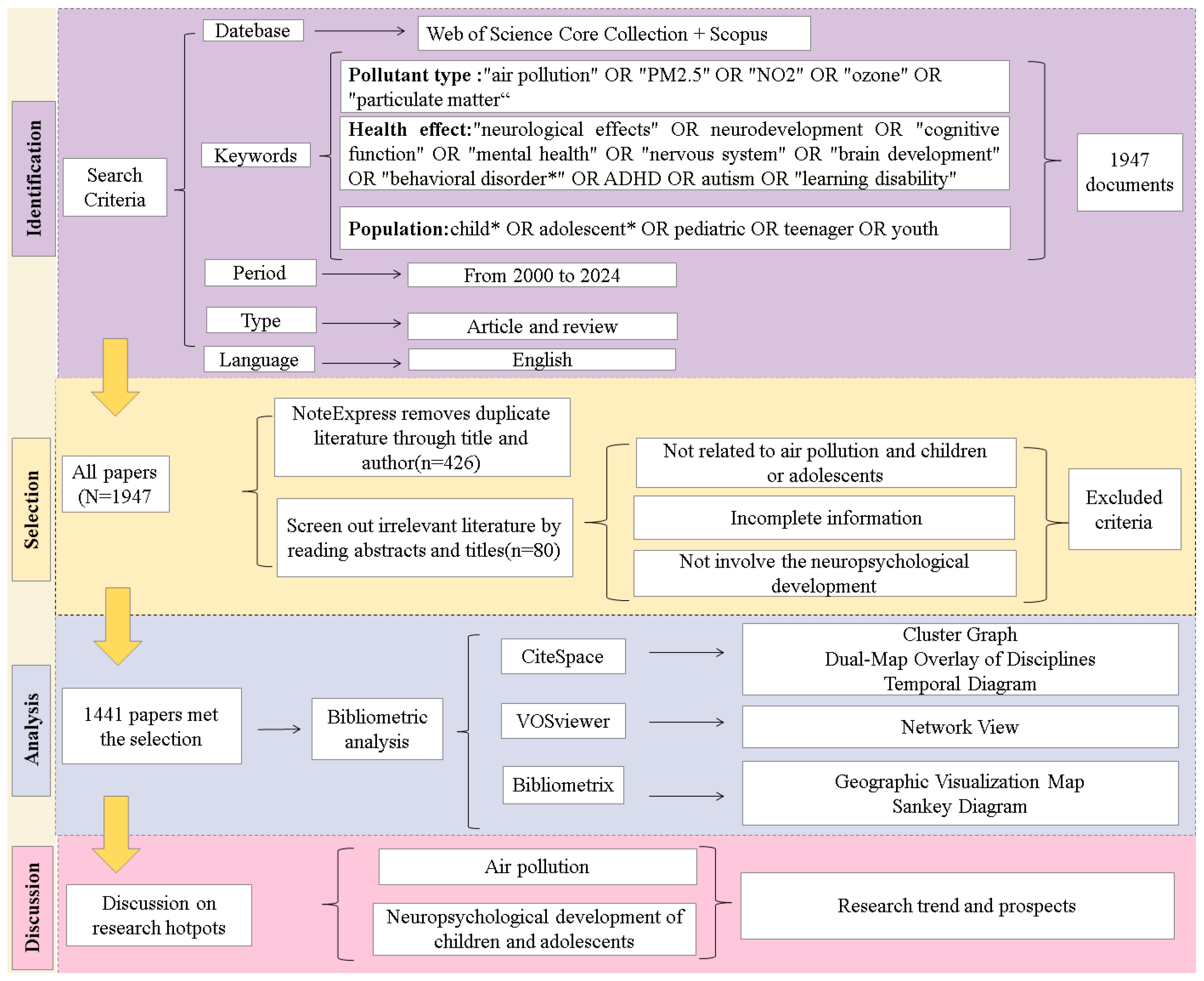
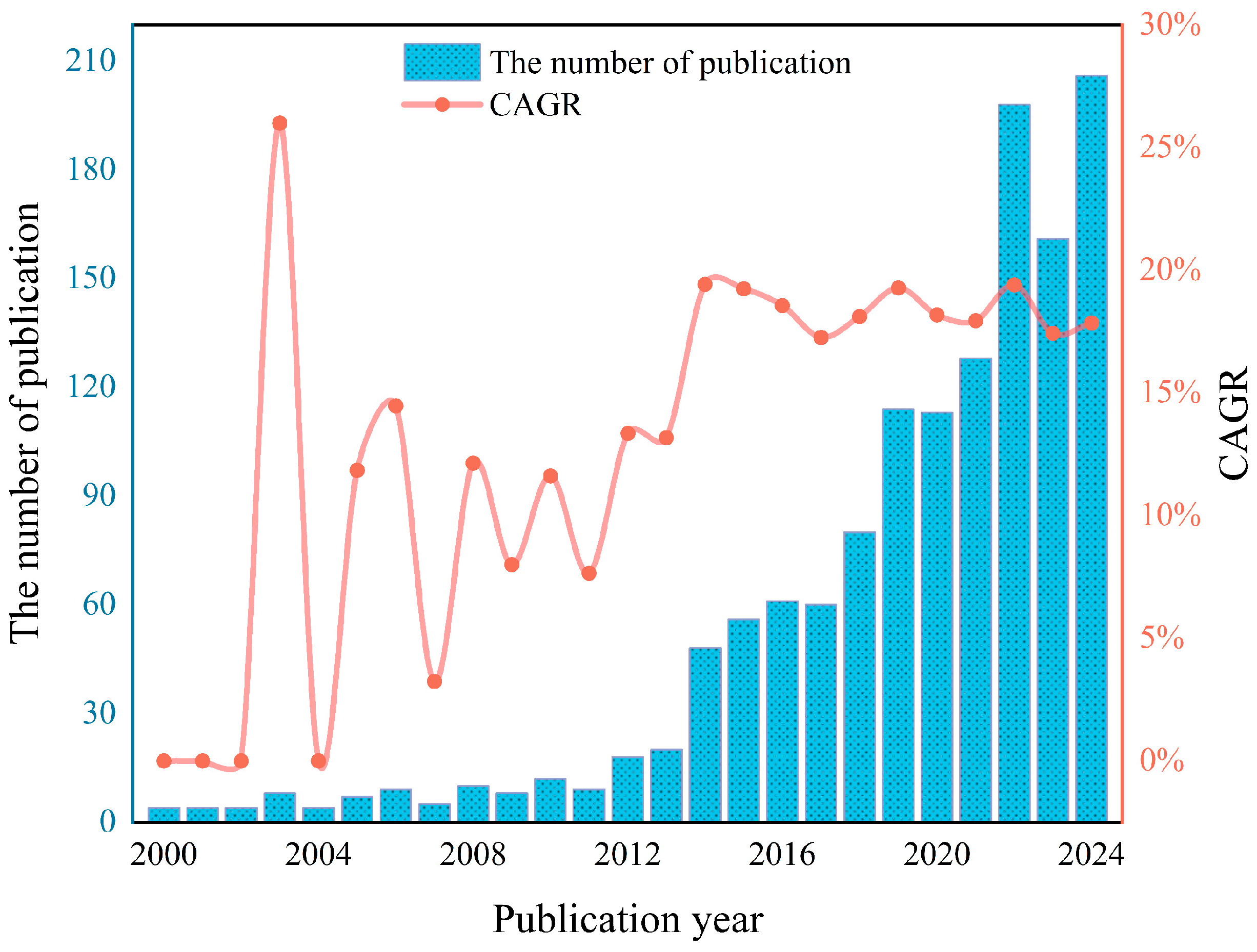
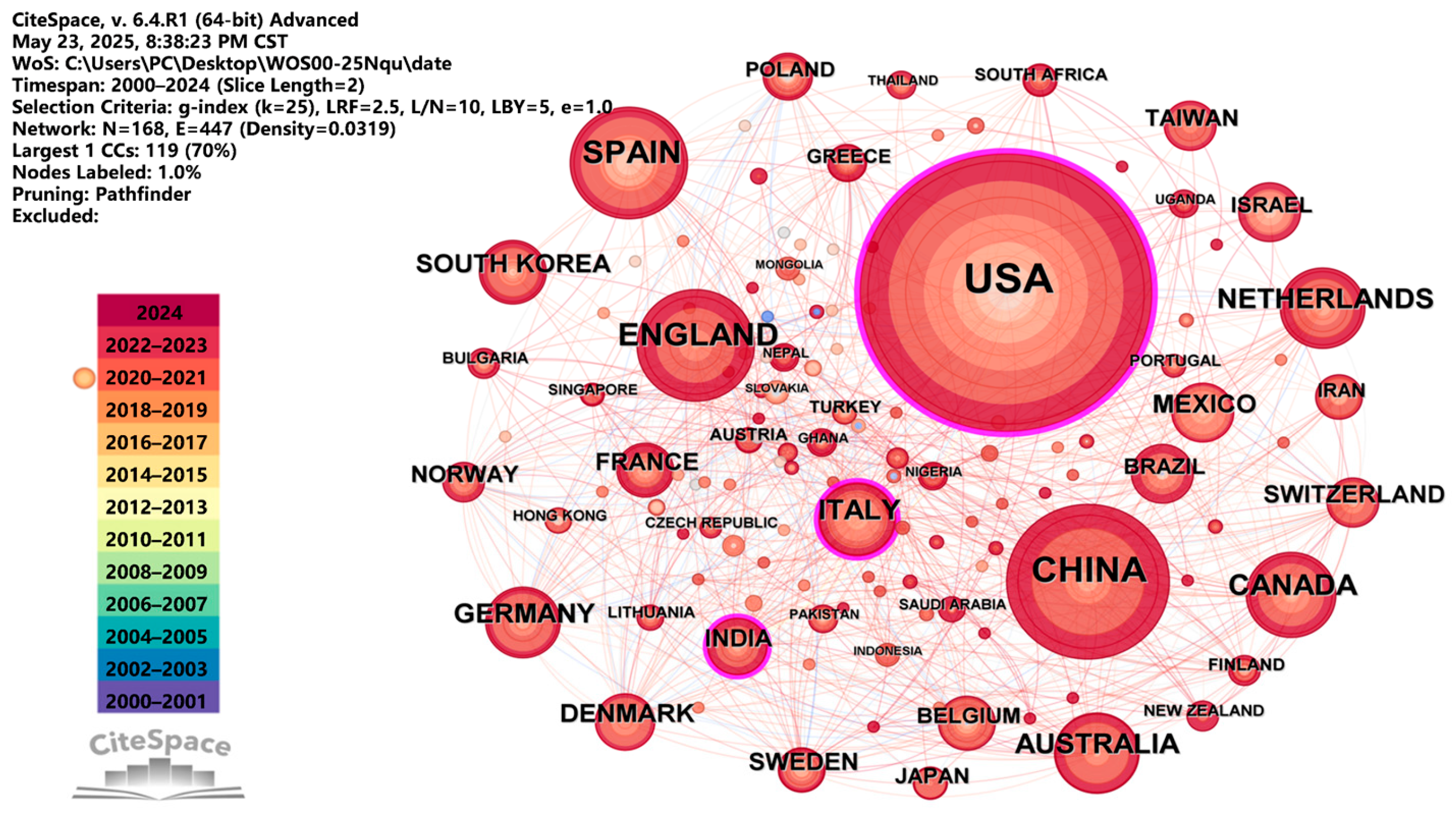
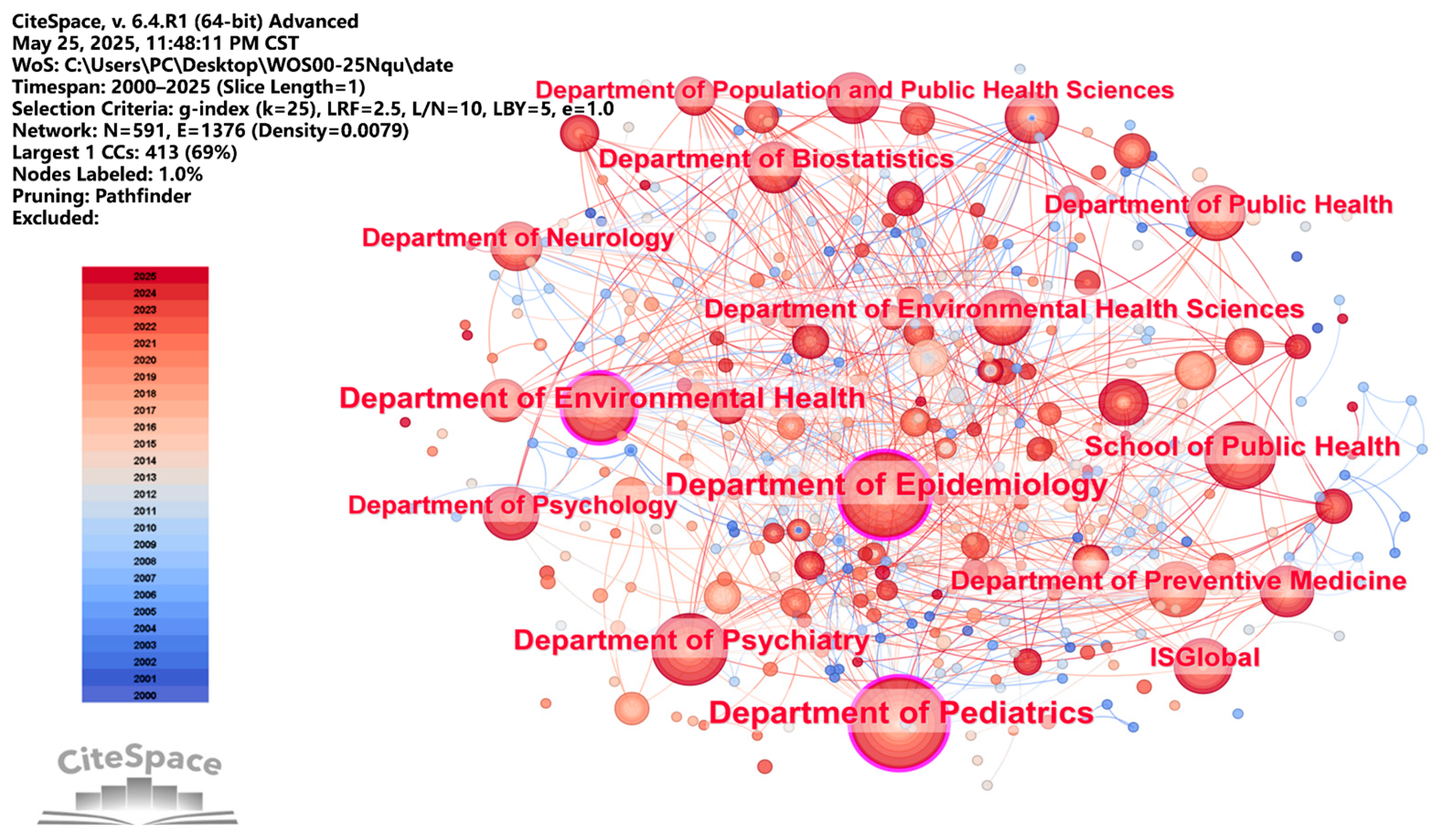

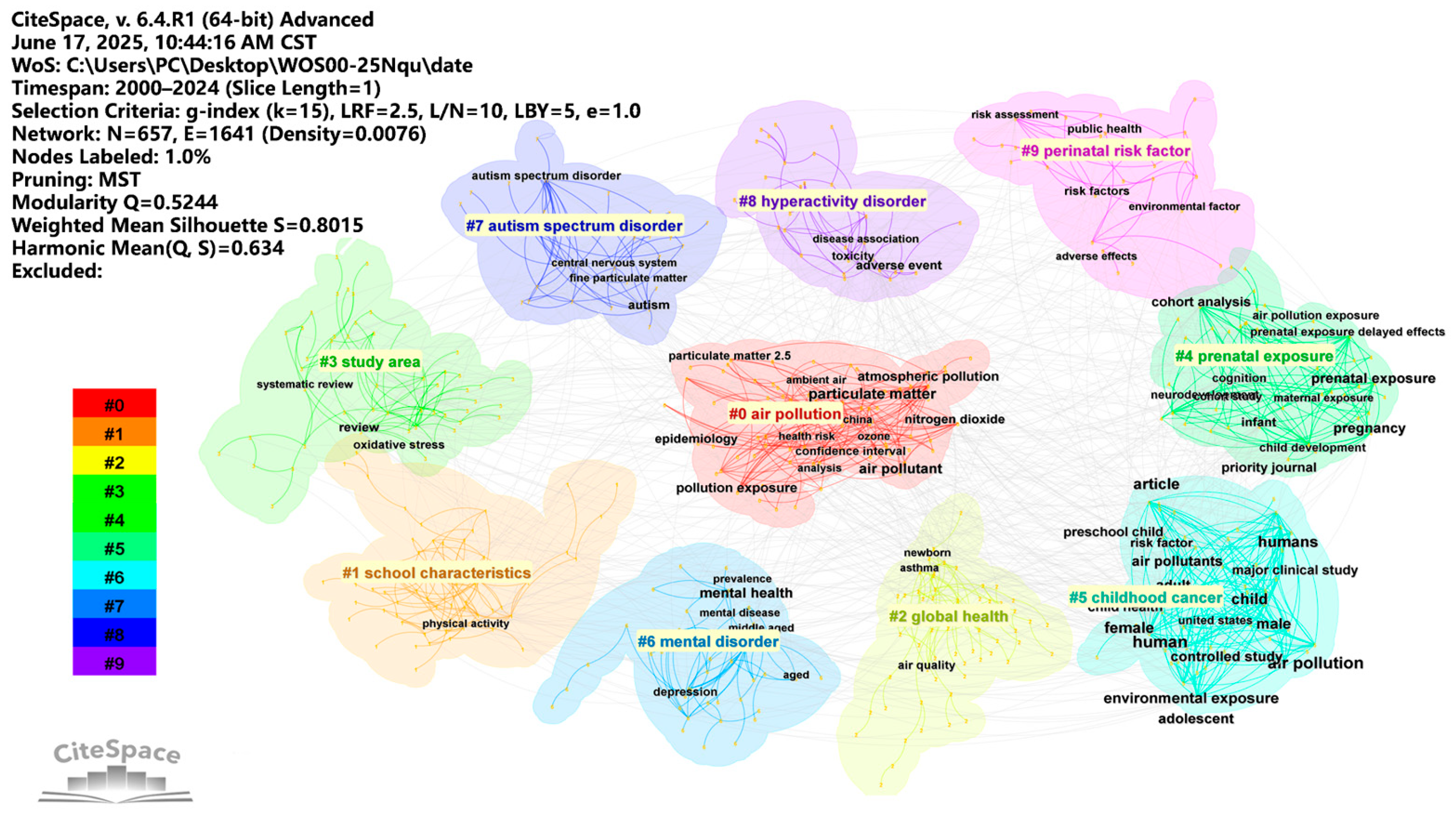
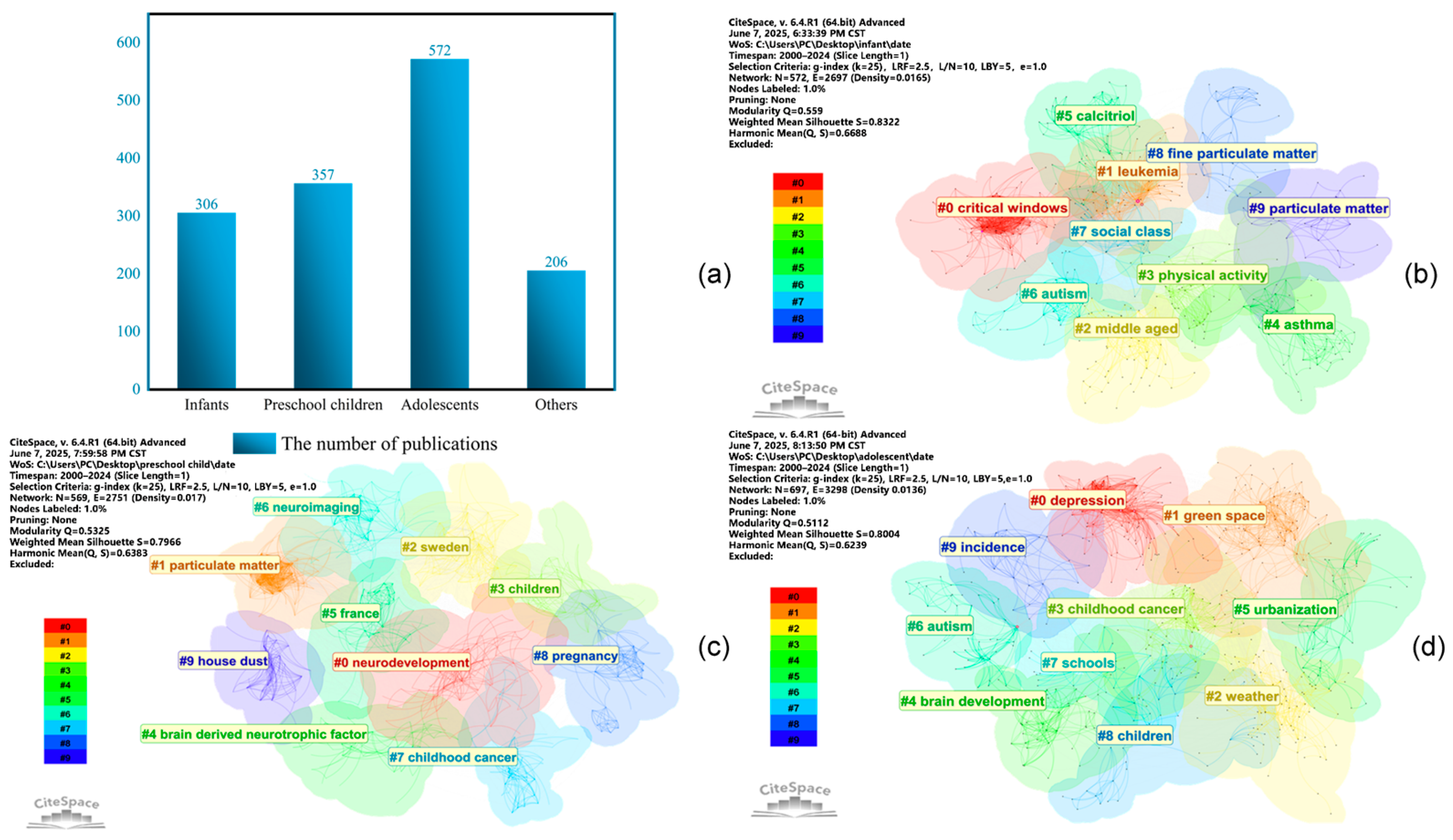
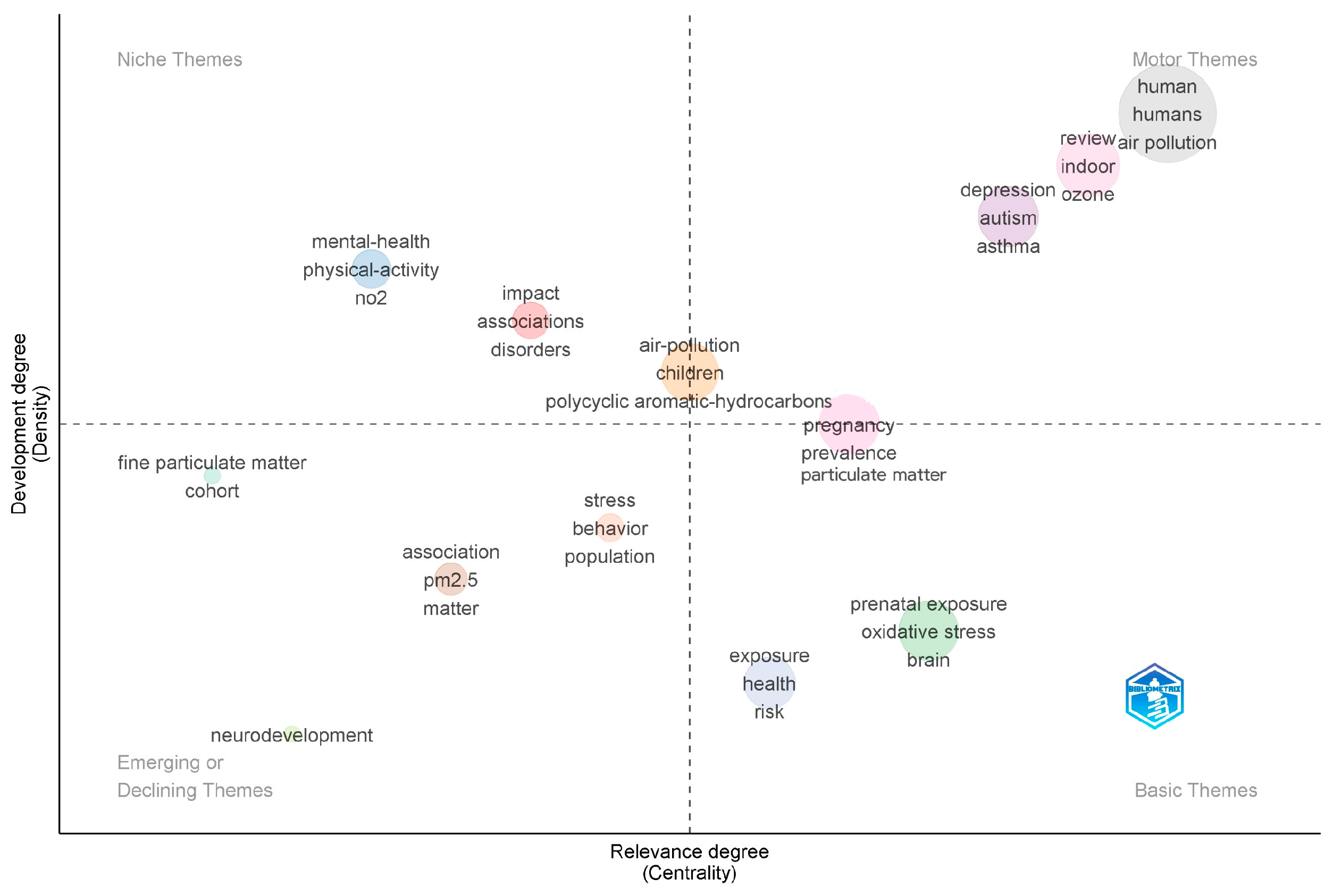
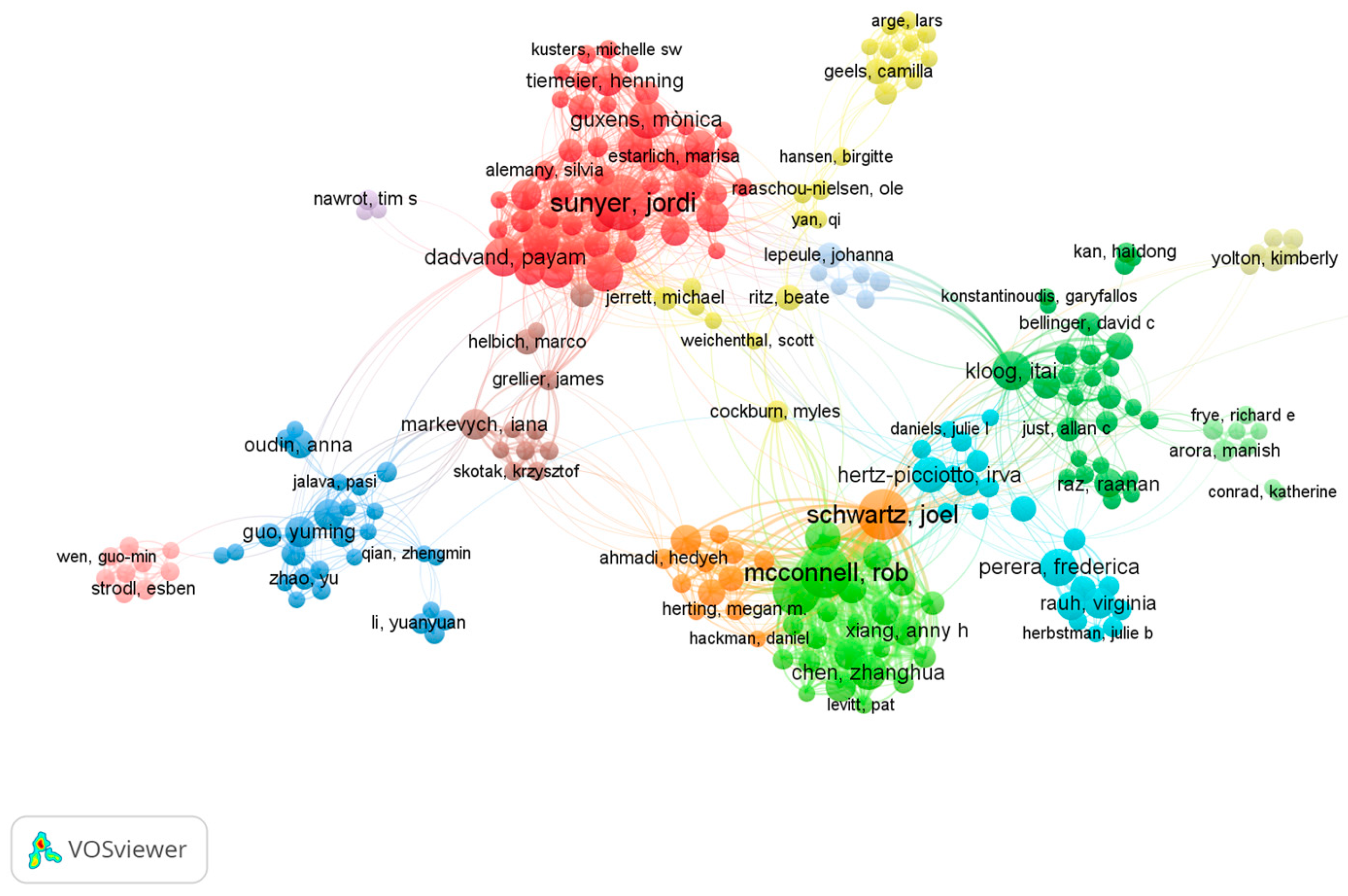

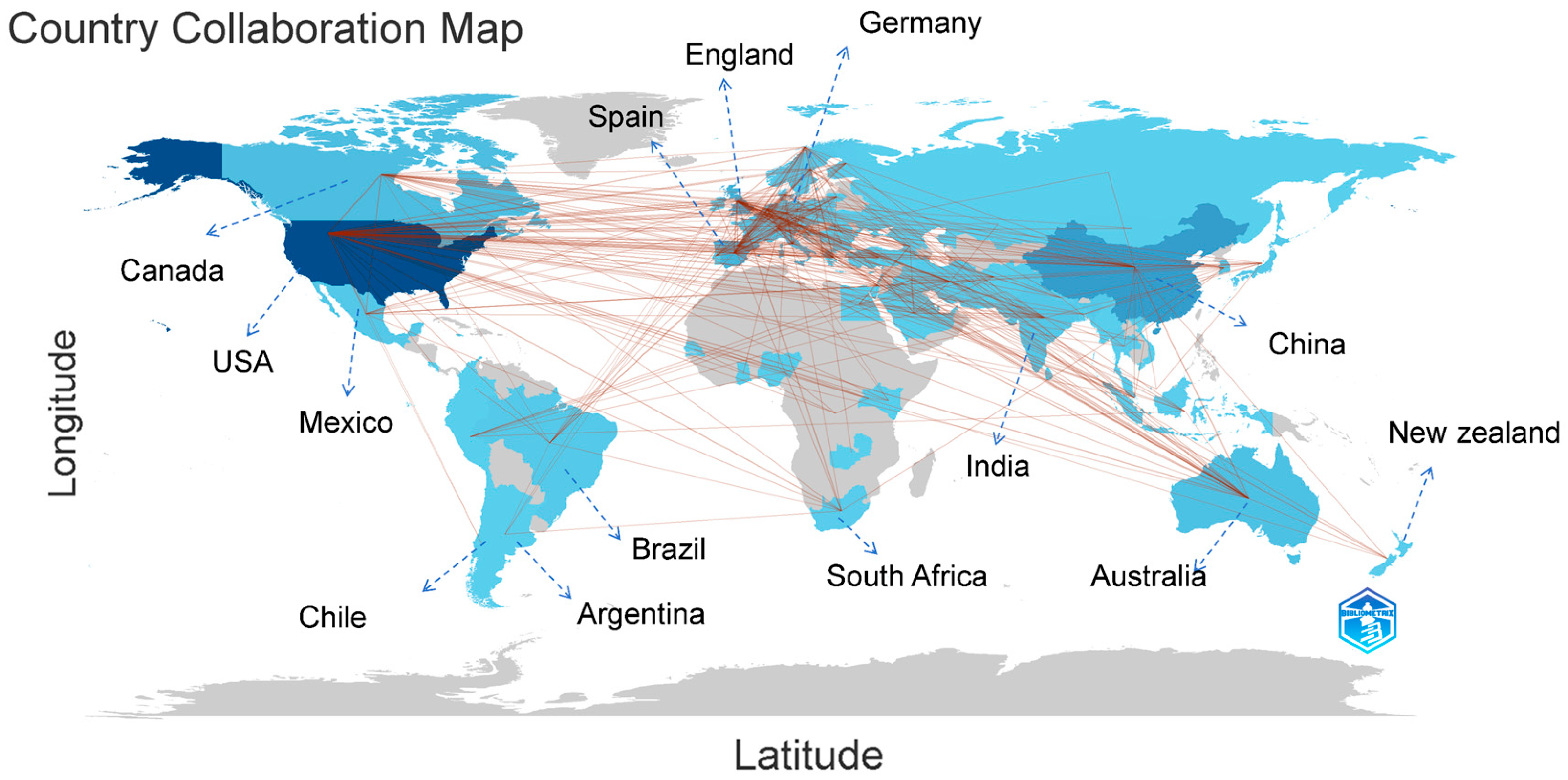
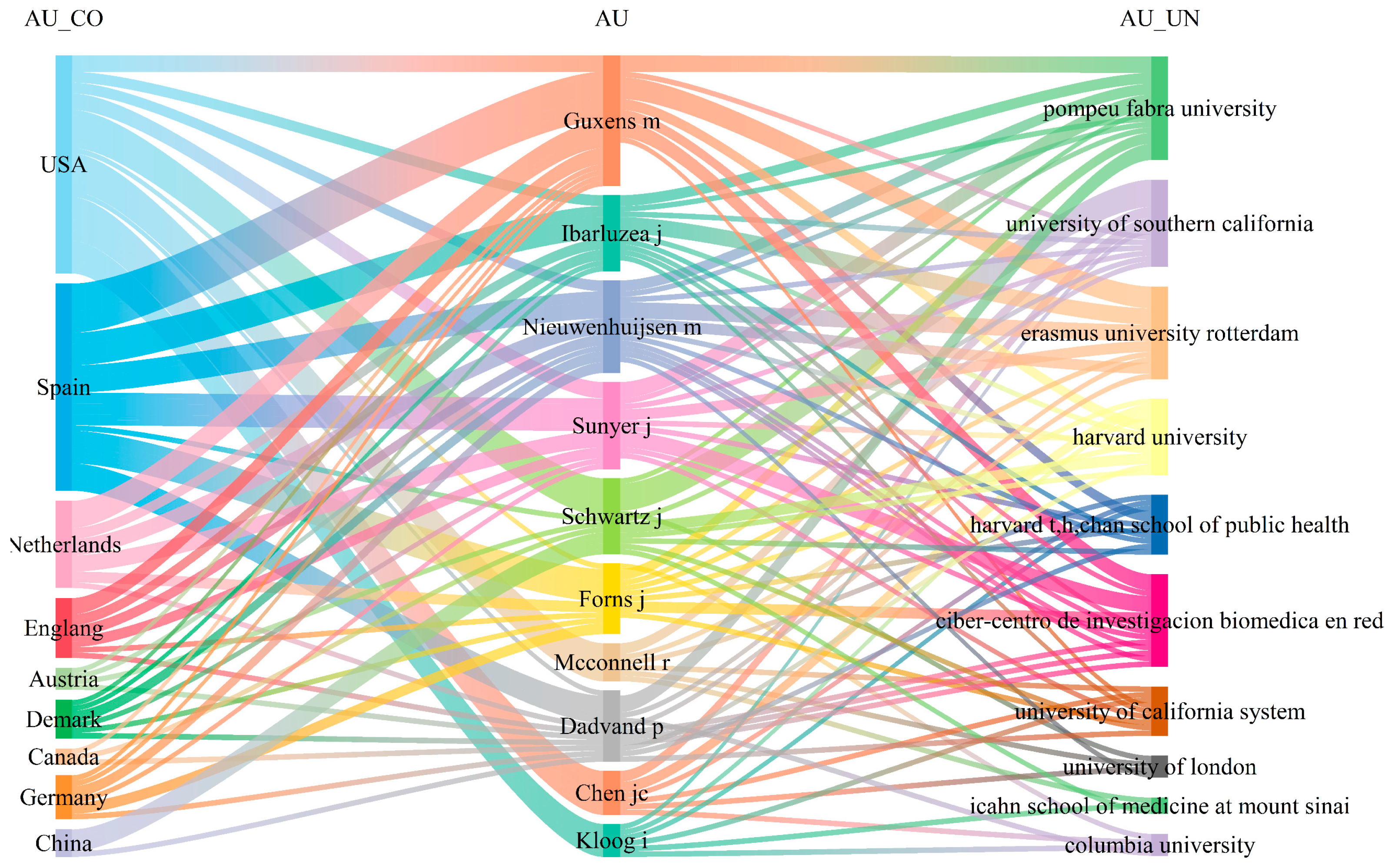
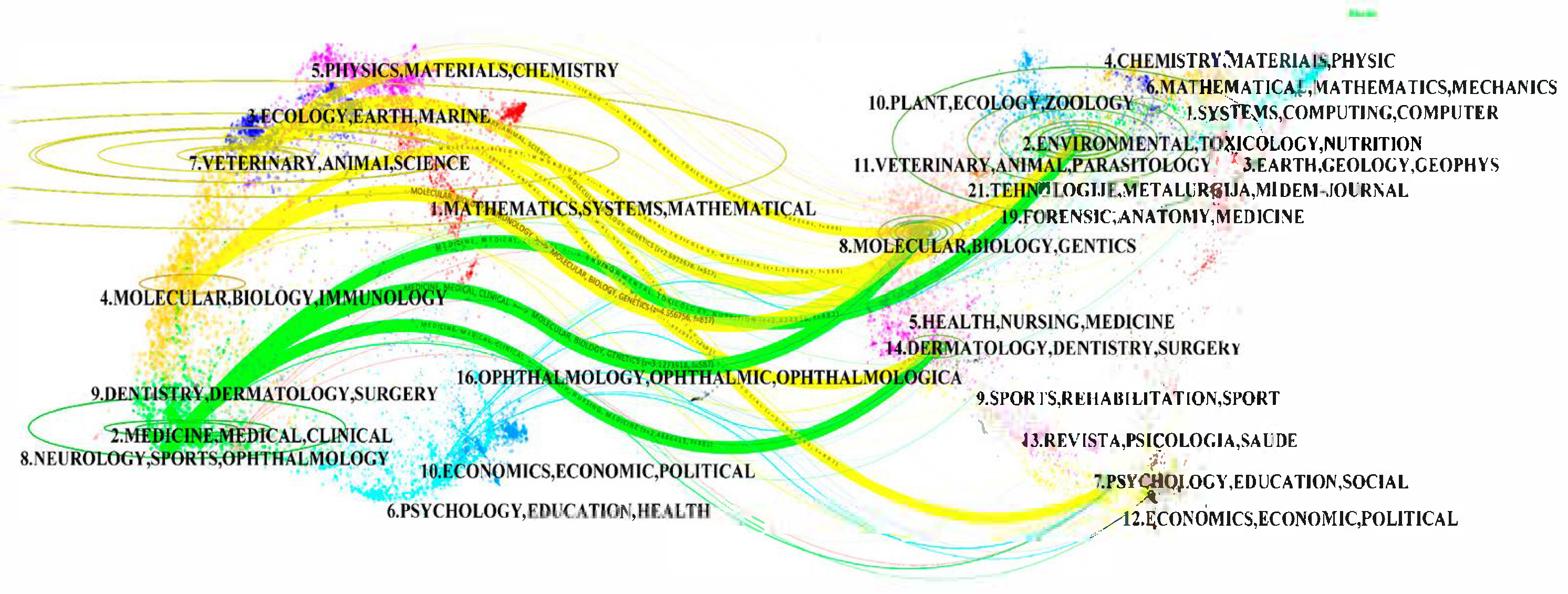

| Published Number | Centrality | Starting Year | Country |
|---|---|---|---|
| 656 | 0.26 | 2000 | USA |
| 205 | 0.08 | 2006 | CHINA |
| 132 | 0.10 | 2003 | ENGLAND |
| 128 | 0.05 | 2002 | SPAIN |
| 78 | 0.12 | 2001 | CANADA |
| 70 | 0.13 | 2012 | AUSTRALIA |
| 68 | 0.01 | 2005 | THE NETHERLANDS |
| 61 | 0.08 | 2006 | ITALY |
| 60 | 0.06 | 2005 | GERMANY |
| 46 | 0.07 | 2010 | MEXICO |
| Publication Numbers | Centrality | Starting Year | Institute |
|---|---|---|---|
| 95 | 0.16 | 2003 | Department of Pediatrics |
| 94 | 0.13 | 2005 | Department of Epidemiology |
| 74 | 0.18 | 2005 | Department of Environmental Health |
| 56 | 0.07 | 2013 | Department of Psychiatry |
| 51 | 0.05 | 2008 | School of Public Health |
| 42 | 0.10 | 2008 | Department of Environmental Health Sciences |
| 42 | 0.08 | 2005 | Department of Preventive Medicine |
| 41 | 0.07 | 2010 | Department of Biostatistics |
| 41 | 0.03 | 2017 | ISGlobal |
| 37 | 0.06 | 2013 | Department of Psychology |
| Frequency of High-Frequency Keywords | Centrality of High-Frequency Keywords | ||||
|---|---|---|---|---|---|
| No. | Frequency | Keyword | No. | Frequency | Keyword |
| 1 | 861 | air pollution | 1 | 0.11 | cardiovascular disease |
| 2 | 489 | environmental exposure | 2 | 0.1 | child development |
| 3 | 468 | particulate matter | 3 | 0.09 | controlled study |
| 4 | 368 | air pollutant | 4 | 0.07 | air pollutants |
| 5 | 346 | air pollutants | 5 | 0.07 | ambient air |
| 6 | 346 | controlled study | 6 | 0.07 | environmental factor |
| 7 | 340 | major clinical study | 7 | 0.07 | disease association |
| 8 | 298 | mental health | 8 | 0.06 | indoor air pollution |
| 9 | 242 | cohort analysis | 9 | 0.06 | child health |
| 10 | 236 | preschool child | 10 | 0.06 | air quality |
| 11 | 230 | atmospheric pollution | 11 | 0.06 | air pollutant |
| 12 | 223 | pollution exposure | 12 | 0.06 | risk assessment |
| 13 | 219 | prenatal exposure | 13 | 0.05 | health hazard |
| 14 | 216 | child health | 14 | 0.05 | cohort analysis |
| 15 | 206 | adverse event | 15 | 0.05 | health risk |
| 16 | 198 | nitrogen dioxide | 16 | 0.05 | attention deficit disorder |
| 17 | 196 | risk factor | 17 | 0.04 | central nervous system tumor |
| 18 | 129 | Prenatal exposure delayed effects | 18 | 0.04 | case–control studies |
| 19 | 124 | cohort studies | 19 | 0.04 | preschool child |
| 20 | 122 | Autism spectrum disorder | 20 | 0.04 | brain development |
| Keywords | Year | Strength | Begin | End | 2000–2024 * |
|---|---|---|---|---|---|
| adverse effects | 2005 | 21.4 | 2010 | 2017 | ▂▂▂▂▂▂▂▂▂▂▃▃▃▃▃▃▃▃▂▂▂▂▂▂▂ |
| preschool child | 2003 | 18.77 | 2006 | 2019 | ▂▂▂▂▂▂▃▃▃▃▃▃▃▃▃▃▃▃▃▃▂▂▂▂▂ |
| environmental exposure | 2003 | 18.62 | 2003 | 2016 | ▂▂▂▃▃▃▃▃▃▃▃▃▃▃▃▃▃▂▂▂▂▂▂▂▂ |
| traffic-related air pollution | 2013 | 15.56 | 2013 | 2020 | ▂▂▂▂▂▂▂▂▂▂▂▂▂▃▃▃▃▃▃▃▃▂▂▂▂ |
| disease association | 2009 | 14.23 | 2009 | 2020 | ▂▂▂▂▂▂▂▂▂▃▃▃▃▃▃▃▃▃▃▃▃▂▂▂▂ |
| environmental health | 2002 | 13.35 | 2002 | 2015 | ▂▂▃▃▃▃▃▃▃▃▃▃▃▃▃▃▂▂▂▂▂▂▂▂▂ |
| attention deficit disorder | 2011 | 12.71 | 2011 | 2020 | ▂▂▂▂▂▂▂▂▂▂▂▃▃▃▃▃▃▃▃▃▃▂▂▂▂ |
| pregnancy | 2021 | 11.17 | 2021 | 2023 | ▂▂▂▂▂▂▂▂▂▂▂▂▂▂▂▂▂▂▂▂▂▃▃▃▂ |
| central nervous system | 2001 | 10.71 | 2001 | 2020 | ▂▃▃▃▃▃▃▃▃▃▃▃▃▃▃▃▃▃▃▃▃▂▂▂▂ |
| Autism spectrum disorder | 2014 | 9.98 | 2015 | 2020 | ▂▂▂▂▂▂▂▂▂▂▂▂▂▂▂▃▃▃▃▃▃▂▂▂▂ |
| adolescent | 2021 | 9.31 | 2023 | 2024 | ▂▂▂▂▂▂▂▂▂▂▂▂▂▂▂▂▂▂▂▂▂▂▂▃▃ |
| social status | 2009 | 8.64 | 2019 | 2020 | ▂▂▂▂▂▂▂▂▂▂▂▂▂▂▂▂▂▂▂▃▃▂▂▂▂ |
| nervous system disorder | 2014 | 8.58 | 2014 | 2019 | ▂▂▂▂▂▂▂▂▂▂▂▂▂▂▃▃▃▃▃▃▂▂▂▂▂ |
| cognition | 2021 | 7.55 | 2022 | 2023 | ▂▂▂▂▂▂▂▂▂▂▂▂▂▂▂▂▂▂▂▂▂▂▃▃▂ |
| children | 2021 | 7.23 | 2022 | 2023 | ▂▂▂▂▂▂▂▂▂▂▂▂▂▂▂▂▂▂▂▂▂▂▃▃▂ |
| Author | Number | Institute | Country |
|---|---|---|---|
| Sunyer J | 35 | Barcelona Institute for Global Health | Spain |
| Guxens M | 32 | Barcelona Institute for Global Health | Spain |
| Schwartz J | 24 | Harvard T.H. Chan School of Public Health | USA |
| Mcconnell R | 22 | University of Southern California | USA |
| Chen JC | 20 | University of Southern California | USA |
| Dadvand P | 18 | Barcelona Institute for Global Health | Spain |
| Forns J | 17 | Barcelona Institute for Global Health | Spain |
| Ibarluzea J | 16 | University of Basque Country | Spain |
| Nieuwenhuijsen M | 16 | Barcelona Institute for Global Health | Spain |
| Kloog I | 15 | Icahn School of Medicine at Mount Sinai | USA |
| #0 autism spectrum disorder | #5 mental health crises |
|---|---|
| Volk HE, 2013 [67] (DOI: 10.1001/jamapsychiatry.2013.266) Raz R, 2015 [68] (DOI: 10.1289/ehp.1408133) | Lopuszanska U, 2020 [69] (DOI: 10.1097/WNN.0000000000000235) Zundel CG, 2022 [70] (DOI: 10.1016/j.neuro.2022.10.011) |
| #1 systematic review | #6 utero exposure |
| Dadvand P, 2017 [71] (DOI: 10.1289/EHP694) Markevych I, 2018 [72] (DOI: 10.1016/j.scitotenv.2018.06.167) | Edwards SC, 2010 [73] (DOI: 10.1289/ehp.0901070) Brook, R. D, 2010 [74] (DOI: 10.1161/CIR.0b013e3181dbece1) |
| #2 adverse effect | #7 neurodevelopmental disorder |
| Sunyer J, 2015 [22] (DOI: 10.1371/journal.pmed.1001792) Chiu YHM, 2016 [75] (DOI: 10.1016/j.envint.2015.11.010) | Raz R, 2018 [76] (DOI: 10.1093/aje/kwx294) Calderón-Garcidueñas, L, 2022 [77] (DOI: 10.1021/acs.est.1c04706) |
| #3 intellectual disability | #8 inma cohort |
| Dutheil F, 2021 [78] (DOI: 10.1016/j.envpol.2021.116856) Roberts S, 2019 [79] (DOI: 10.1016/j.psychres.2018.12.050) | Guedes AMFM, 2003 [80] (DOI: 10.1016/S0043-1354(03)00178-7) Martínez NS, 2003 [81] (DOI: 10.1016/S0304-3894(03)00207-3) |
| #4 environmental noise | #9 critical proton mr |
| Peterson BS, 2015 [82] (DOI: 10.1001/jamapsychiatry.2015.57) Forns J, 2016 [83] (DOI: 10.1289/ehp.1409449) | Calderón-Garcidueñas L, 2012 [84] (DOI: 10.3389/fpsyg.2012.00217) Jerrett M, 2014 [85] (DOI: 10.1186/1476-069X-13-49) |
| Journals | Documents | Average Citations per Article | Total Link Strength | Rate% |
|---|---|---|---|---|
| Environmental research | 109 | 34 | 44,581 | 7.56% |
| Environment international | 59 | 38 | 27,081 | 4.09% |
| Environmental pollution | 28 | 26 | 13,720 | 1.94% |
| Environmental health perspectives | 24 | 88 | 11,856 | 1.66% |
| Ecotoxicology and environmental safety | 16 | 14 | 8032 | 1.11% |
| Environmental health | 15 | 19 | 7545 | 1.04% |
| Environmental science and Pollution research | 13 | 24 | 6565 | 0.90% |
| Bmc public health | 11 | 14 | 5577 | 0.76% |
| Epidemiology | 11 | 85 | 5577 | 0.76% |
| Bmj open | 10 | 17 | 5080 | 0.69% |
Disclaimer/Publisher’s Note: The statements, opinions and data contained in all publications are solely those of the individual author(s) and contributor(s) and not of MDPI and/or the editor(s). MDPI and/or the editor(s) disclaim responsibility for any injury to people or property resulting from any ideas, methods, instructions or products referred to in the content. |
© 2025 by the authors. Licensee MDPI, Basel, Switzerland. This article is an open access article distributed under the terms and conditions of the Creative Commons Attribution (CC BY) license (https://creativecommons.org/licenses/by/4.0/).
Share and Cite
Lei, Q.; Li, X.; Guo, X.; Chen, J.; Yi, C. Neuropsychological Effects of Air Pollution on Children and Adolescents (0–18 Years): A Global Bibliometric Analysis. Atmosphere 2025, 16, 1164. https://doi.org/10.3390/atmos16101164
Lei Q, Li X, Guo X, Chen J, Yi C. Neuropsychological Effects of Air Pollution on Children and Adolescents (0–18 Years): A Global Bibliometric Analysis. Atmosphere. 2025; 16(10):1164. https://doi.org/10.3390/atmos16101164
Chicago/Turabian StyleLei, Qiurong, Xingzhou Li, Xuxu Guo, Jing Chen, and Chuanjian Yi. 2025. "Neuropsychological Effects of Air Pollution on Children and Adolescents (0–18 Years): A Global Bibliometric Analysis" Atmosphere 16, no. 10: 1164. https://doi.org/10.3390/atmos16101164
APA StyleLei, Q., Li, X., Guo, X., Chen, J., & Yi, C. (2025). Neuropsychological Effects of Air Pollution on Children and Adolescents (0–18 Years): A Global Bibliometric Analysis. Atmosphere, 16(10), 1164. https://doi.org/10.3390/atmos16101164







